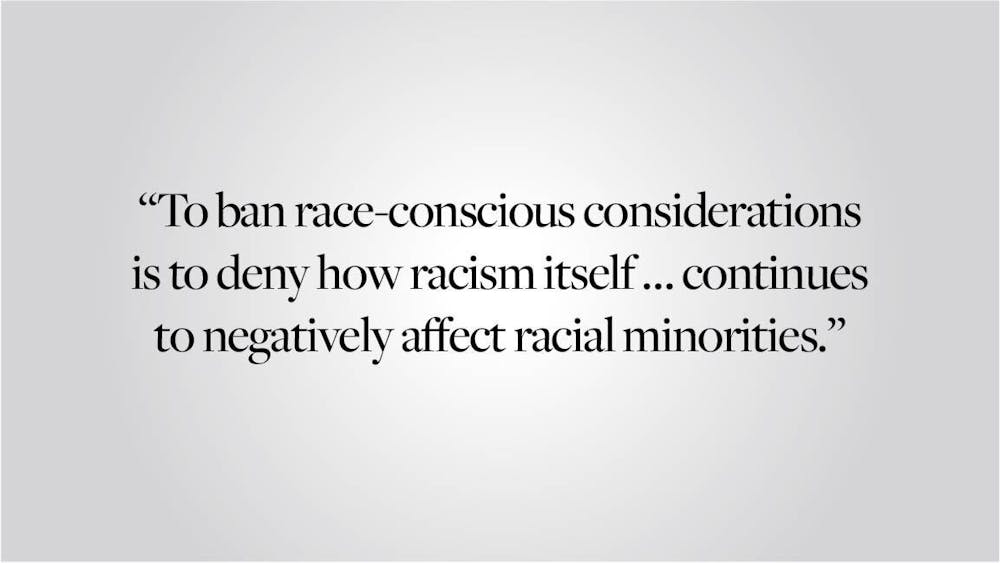The Supreme Court seems poised to ban affirmative action, the use of race-conscious considerations in college admissions. During hearings in late October, members of the court’s conservative majority made no efforts to hide their skepticism of affirmative action’s constitutionality as used at Harvard and the University of North Carolina.
The court’s expected ruling against Harvard and UNC would dismantle years of legal precedent and send shockwaves through universities nationwide. On College Hill, a blanket ban on affirmative action would undermine our admission process.
Brown joined an amicus brief this year with 14 other institutions of higher education defending Harvard and UNC and affirming its support for affirmative action. The brief quotes former Brown President Ruth Simmons: “We know that difference is one of the primary means for students to test themselves, to test their background, to test their ideas, to challenge assumptions. And in that context, it is in coming in contact with difference that we tend to deepen our learning.”
Race-conscious considerations help universities create diverse communities. As decades of research have shown, a racially diverse student body benefits students who get to interact with others of different backgrounds. Affirmative action works to build that kind of student body ― evidence suggests that when affirmative action is banned, racial diversity falls.
And the use of race in admissions not only helps universities and colleges build diverse communities ― it empowers them to address the effects of racism. Racism continues to hinder the health, career opportunities and educational opportunities of racial minorities. Black, Hispanic, Native American and Pacific Islander students, for example, continue to be underrepresented in higher education. So long as racial inequality exists, affirmative action is a crucial corrective, helping provide marginalized students with opportunities they would otherwise be unjustly denied.
Some opponents claim that affirmative action is itself an unfair form of discrimination. Arguing against the practice in 2007, Chief Justice John Roberts wrote, “The way to stop discrimination on the basis of race is to stop discriminating on the basis of race.” But our world is not simple nor color-blind enough for this reductive color-blind logic to work. In a world where racial inequality persists, true equality requires us not to turn away from issues of race but to confront them head on. To ignore race entirely is to pretend, naively, that the system is now fair.
Others have argued for alternatives to race-conscious considerations. For example, some have suggested emphasizing students’ socioeconomic status rather than their race in admissions considerations ― an especially salient point at places such as Harvard and Brown, where a disproportionate share of students come from wealthy backgrounds.
However, class — even though it is clearly correlated with race — is not enough to shape a truly diverse student body; race provides a dimension that class can’t fully capture. To ban race-conscious considerations is to deny how racism itself ― not correlates of racism or other forms of oppression ― continues to negatively affect racial minorities. As Tufts University sociologist Natasha Warikoo puts it, “Racial inequality is not just class in disguise.”
Still others question the meaning of diversity itself. During the hearings in October, Justice Clarence Thomas stated, “I’ve heard the word diversity quite a few times, and I don’t have a clue what it means.” In Thomas’s view, students attend college simply to learn “physics or chemistry or whatever they’re studying.”
But the purpose of a college education has never been merely about learning “physics or chemistry.” It has long entailed learning from peers ― and racial diversity makes for richer learning. It also provides a pathway to opportunities and upward mobility. As Justice Elena Kagan said in October hearings, universities, especially the elite universities at the heart of current litigation, “are the pipelines to leadership in our society.” And in a pluralistic democracy, a society’s leaders must reflect that society in all of its diversity.
Yes, diversity is hard to define exactly ― and race is only one part of the picture. There will never be an exact calculus for determining when a community is diverse enough. And yet, while questions of diversity are complicated, this does not mean we shouldn’t wrestle with them. We have a responsibility to address the societal implications of racism, and affirmative action is one of the tools to do so. It is no silver bullet ― and conversations about diversity should not end with affirmative action ― but it is still necessary.
Affirmative action has made a difference. As Assistant Professor of Political Science, Public Policy and Education Jonathan Collins told The Herald, the policy’s impact is visible during commencement, when graduating students and alums walk through the Van Wickle Gates. Year by year, the classes get more diverse: “You start to see graduating classes from Brown University that start to better reflect the makeup of not just the country, but the world.”
We have made progress. But in losing affirmative action, we would be taking a step back.
Editorials are written by The Herald’s Editorial Page Board. This editorial was written by its editor Johnny Ren ’23 and members Irene Chou ’23, Caroline Nash ’22.5, Augustus Bayard ’24, Devan Paul ’24 and Kate Waisel ’24.





